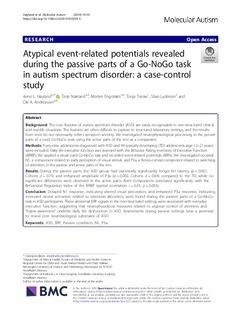| dc.contributor.author | Høyland, Anne Lise | |
| dc.contributor.author | Nærland, Terje | |
| dc.contributor.author | Engstrøm, Morten | |
| dc.contributor.author | Torske, Tonje | |
| dc.contributor.author | Lydersen, Stian | |
| dc.contributor.author | Andreassen, Ole Andreas | |
| dc.date.accessioned | 2019-03-18T07:24:29Z | |
| dc.date.available | 2019-03-18T07:24:29Z | |
| dc.date.created | 2019-03-17T11:19:35Z | |
| dc.date.issued | 2019 | |
| dc.identifier.issn | 2040-2392 | |
| dc.identifier.uri | http://hdl.handle.net/11250/2590357 | |
| dc.description.abstract | Background
The core features of autism spectrum disorder (ASD) are easily recognizable in non-structured clinical and real-life situations. The features are often difficult to capture in structured laboratory settings, and the results from tests do not necessarily reflect symptom severity. We investigated neurophysiological processing in the passive parts of a cued Go-NoGo task, using the active parts of the test as a comparator.
Methods
Forty-nine adolescents diagnosed with ASD and 49 typically developing (TD) adolescents (age 12–21 years) were included. Daily life executive function was assessed with the Behavior Rating Inventory of Executive Function (BRIEF). We applied a visual cued Go-NoGo task and recorded event-related potentials (ERPs). We investigated occipital N1, a component related to early perception of visual stimuli, and P3a, a fronto-central component related to switching of attention, in the passive and active parts of the test.
Results
During the passive parts, the ASD group had statistically significantly longer N1 latency (p < 0.001, Cohens d = 0.75) and enhanced amplitude of P3a (p = 0.002, Cohens d = 0.64) compared to the TD, while no significant differences were observed in the active parts. Both components correlated significantly with the Behavioral Regulation Index of the BRIEF (partial correlation r = 0.35, p = 0.003).
Conclusion
Delayed N1 response, indicating altered visual perception, and enhanced P3a response, indicating increased neural activation related to attention allocation, were found during the passive parts of a Go-NoGo task in ASD participants. These abnormal ERP signals in the non-structured settings were associated with everyday executive function, suggesting that neurophysiolocal measures related to atypical control of alertness and “hyper-awareness” underlie daily life dysfunction in ASD. Assessments during passive settings have a potential to reveal core neurobiological substrates of ASD. | nb_NO |
| dc.language.iso | eng | nb_NO |
| dc.publisher | BioMed Central | nb_NO |
| dc.rights | Navngivelse 4.0 Internasjonal | * |
| dc.rights.uri | http://creativecommons.org/licenses/by/4.0/deed.no | * |
| dc.title | Atypical event-related potentials revealed during the passive parts of a Go-NoGo task in autism spectrum disorder a case-control study | nb_NO |
| dc.type | Journal article | nb_NO |
| dc.type | Peer reviewed | nb_NO |
| dc.description.version | publishedVersion | nb_NO |
| dc.source.journal | Molecular Autism | nb_NO |
| dc.identifier.doi | 10.1186/s13229-019-0259-3 | |
| dc.identifier.cristin | 1685358 | |
| dc.description.localcode | © The Author(s). 2019. Open Access. This article is distributed under the terms of the Creative Commons Attribution 4.0 International License (http://creativecommons.org/licenses/by/4.0/), which permits unrestricted use, distribution, and reproduction in any medium, provided you give appropriate credit to the original author(s) and the source, provide a link to the Creative Commons license, and indicate if changes were made. | nb_NO |
| cristin.unitcode | 194,65,35,5 | |
| cristin.unitcode | 194,65,30,0 | |
| cristin.unitname | RKBU Midt-Norge - Regionalt kunnskapssenter for barn og unge - psykisk helse og barnevern | |
| cristin.unitname | Institutt for nevromedisin og bevegelsesvitenskap | |
| cristin.ispublished | true | |
| cristin.fulltext | original | |
| cristin.qualitycode | 1 | |

